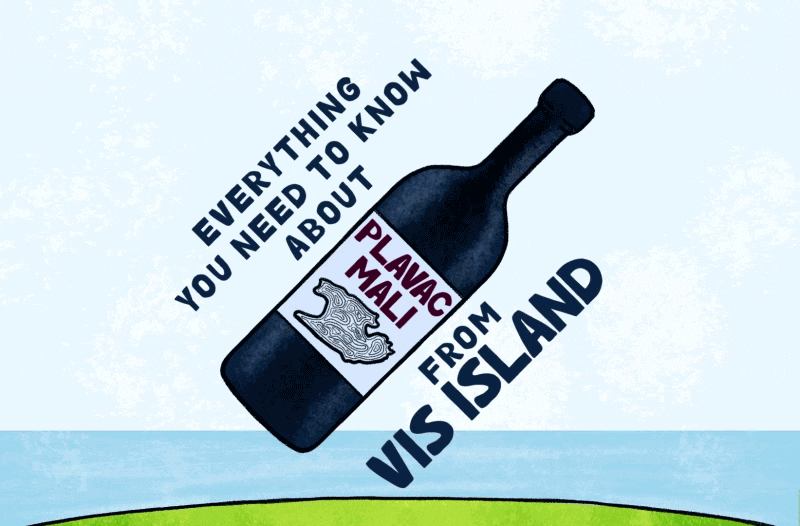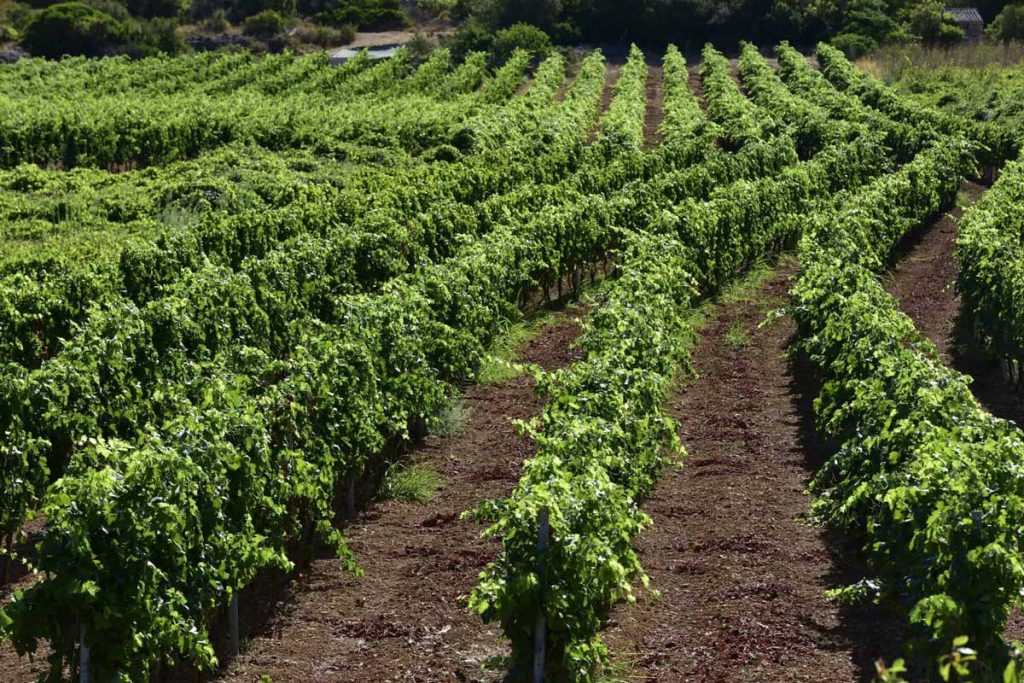December 04, 2023. – From its royal status as the “King of Croatian Reds” to its unique characteristics that set it apart, this article written by Wine & more is your passport to the wine adventure of a lifetime. Embark on a breathtaking journey through the Vis Island as we reveal the captivating secrets of the sensational Plavac Mali grape!

What are the characteristics of Plavac Mali?
Key characteristics of Plavac Mali are:
- Colour: Plavac Mali wines typically have a deep red to garnet colour, reflecting the dark pigments in the grape skins.
- Aroma: The Plavac Mali wines are known for their complex aromatic profile, meaning they change and develop in a wine glass. They often exhibit notes of dark fruits such as carob, dark cherries, and sometimes even dried fruits like figs and plums. You might also find hints of Mediterranean herbs, such as sage or thyme, and spicy and peppery notes are quite common.
- Body: High-quality Plavac Mali wines are generally full-bodied. Plavac Mali performs best as full or fuller-bodied wine. There are examples of high-quality Plavac Mali wines, which are lighter-bodied. However, those are primarily curious exceptions from the general rule.
- Tannins: Plavac Mali wines are known for their robustness and noticeable tannic structure. The tannins in Plavac Mali wines provide a firm structure, which can contribute to their ageing ability. Over time, these wines may mellow and become more integrated, enhancing their quality. Plavac Mali wines are often aged in wooden barrels, which soften the tannins. However, there are also quality examples of Plavac Mali wines made in stainless steel tanks.
- Alcohol Content: Plavac Mali grapes grow in the carst, rocky soils of sun-drenched Dalmatia and tend to accumulate high levels of sugar. As a result, Plavac Mali wines usually have a moderate (13.5%) to high alcohol content (16%), which contributes to their richness and warmth. The ability to achieve a high alcohol content while maintaining balance is a critical characteristic of high-quality Plavac Mali wines.
- Terroir Influence: Plavac Mali wines can exhibit varying characteristics based on where the grapes are grown. The unique terroir of different subregions and microclimates can result in distinct nuances and expressions. The most well-known appellations of Plavac Mali are located in Dingač and Postup on the Pelješac peninsula, while the newest appellation is in Komarna, on the opposite side of the peninsula. The best Plavac Mali sites can be found on the islands of Hvar, Brač, and Vis.
- Ageing Potential: Plavac Mali wines of high quality have demonstrated their ability to improve and deepen with age when stored in bottles. The best examples of Plavac Mali wines beautifully develop after 20 years or more in bottles. These wines can age gracefully, as their flavors mature and harmonize over time.
Unlocking the Taste of Plavac Mali
Plavac Mali wines are known for their distinct and robust flavor profile, which is often characterized by a combination of the following:
- Dark Fruits: Plavac wines typically feature rich flavours of dark fruits, such as blackberries and plums. They sometimes express dried fruits, especially dried figs or cherries.
- Spices and herbs: Plavac Mali wines often have spicy elements, including hints of black pepper and Mediterranean spices like thyme or sage. Many Plavac wines exhibit herbal characteristics, reflecting the influence of the Mediterranean climate on the grapevines.
- Minerality: Depending on the specific terroir where the grapes are grown, Plavac Mali wines may exhibit mineral notes. The influence of the coastal environment and the rocky soils of some vineyards can contribute to a sense of minerality in the wine. This aspect is generally more stony than earthy.
- Pronounced tannins: Plavac Mali wines are known for their firm tannins, which contribute to the wine’s structure. In inferior vintages or lesser positions, Plavac might even have green tannins. In many circumstances, tannins will be leathery. In well-balanced Plavac wines, tannins are an essential part of varietal character.
- Full Body: Plavac Mali wines are generally full-bodied, meaning they have a weighty and substantial feel on the palate. This contributes to the wine’s overall richness and intensity.
- Alcohol Warmth: Plavac Mali wines often have a moderate to high alcohol content, which can add a warming sensation, especially in the finish. Alcohol levels present the greatest challenge of achieving balance in Plavac wines today.
- Lower acidity: This is part of the overall grape profile of Plavac Mali. Lower acidity can sometimes make a wine’s fruit flavours appear more prominent, creating a perception of sweetness, even if the wine is technically dry.
Typical Plavac Mali flavours and aromas include:
- carob,
- sage, thyme,
- dried figs, dried cherries,
- dark cherries, blueberries and plums,
- pepper, and spices, leathery aromas,
- stony minerality.
Vis Island’s Magic: Why is Plavac Mali Different?
Plavac Mali, when grown on Vis Island, has an exceptional quality of carrying a higher alcohol content without compromising the balance. This ability to maintain balance even with higher alcohol levels is what sets the Vis Island Plavac Mali apart from the rest.
Several factors contribute to this phenomenon beyond the customary considerations of farming and growing practices. The soil type on Vis Island plays a crucial role in influencing ripening conditions.
Vis Island is known for its vineyard soil which is comparatively sandier than other regions where premium Plavac Mali is grown. The island’s many vineyards display sand sediment both in the topsoil and throughout the soil composition.
This sandy soil composition is believed to play a significant role in helping the Plavac Mali vines on Vis Island attain ideal ripening conditions. As a result, the wines produced maintain a harmonious balance, even at elevated alcohol levels.
So, when you see 15% alc or more on a bottle of Plavac, do not automatically think the wine will feel over-alcoholic. If it comes from Vis island, there is a great chance it can handle ever higher alcohol with ease. You might not even notice the alcoholic strength in the best examples.
Vislander Plavac Mali Showdown: Age, Soil, and Personality

Soil and the age of the vineyard play significant roles in shaping the distinct characteristics of Plavac Mali wines. A valuable exercise in understanding these nuances involves comparing the same vintage across four different Plavac Mali wines sourced from distinct vineyards on Vis Island.
For instance, Plavac Mali from Voščice originates from grapes cultivated in a vineyard aged over 15 years, while Plavac from Ljubišće comes from a vineyard that is 85% older than 15 years. This age difference in vineyards contributes to variations in grape maturity, vine balance, and overall flavour development.
In contrast, Vislander Plavac from Milna and Tihobraće vineyards comes from expanded and replanted vineyards, which are, on average, younger.
Despite their relative youth, the yields from Milna and Tihobraće are lower compared to Voščice and Ljubišće Plavac wines. This lower yield can intensify the grapes’ flavour concentration, resulting in wines with a more pronounced character.
Beyond the age of the vines, soil composition and winemaking practices further differentiate these Plavac Mali expressions.
Plavac wines from Ljubišće and Voščice are generally more approachable when young. They serve as excellent “starter” wines with a fruit-forward profile and lower alcohol content, making them accessible to a broader range of wine enthusiasts.
On the other hand, Plavac Mali wines from Milna and Tihobraće exhibit a different personality. They are more concentrated, higher in tannin, and have a much darker flavour profile.
The increased tannin structure adds depth and complexity to these wines, making them suitable for those who appreciate a more robust and age-worthy red wine.
This comparison underscores the impact of vineyard age, yield, soil composition, and winemaking choices on the final expression of Vislander Plavac Mali.
Each vineyard imparts its unique character to the wine, providing a diverse array of options for enthusiasts seeking distinct experiences within the rich tapestry of Plavac Mali wines from Vis Island.
Conclusion
In summary, exploring Plavac Mali from Vis Island reveals diverse characteristics that distinguish these wines within Croatian viticulture.
Comparing Plavac Mali wines from different Vis Island vineyards emphasizes the impact of vineyard age, soil, and winemaking on the final product.
From older vineyards yielding approachable wines (in an example of Vislander Voščice and Ljubišće) to younger, concentrated expressions (in an example of Vislander Milna and Tihobraće), each imparts a distinct personality to the Plavac Mali.
In essence, the journey into Vis Island’s Plavac Mali is a captivating exploration of a grape deeply embedded in Croatian winemaking, offering wine enthusiasts diverse and authentic expressions from the Adriatic.
NOTE: The article was originally written at wineandmore.com











